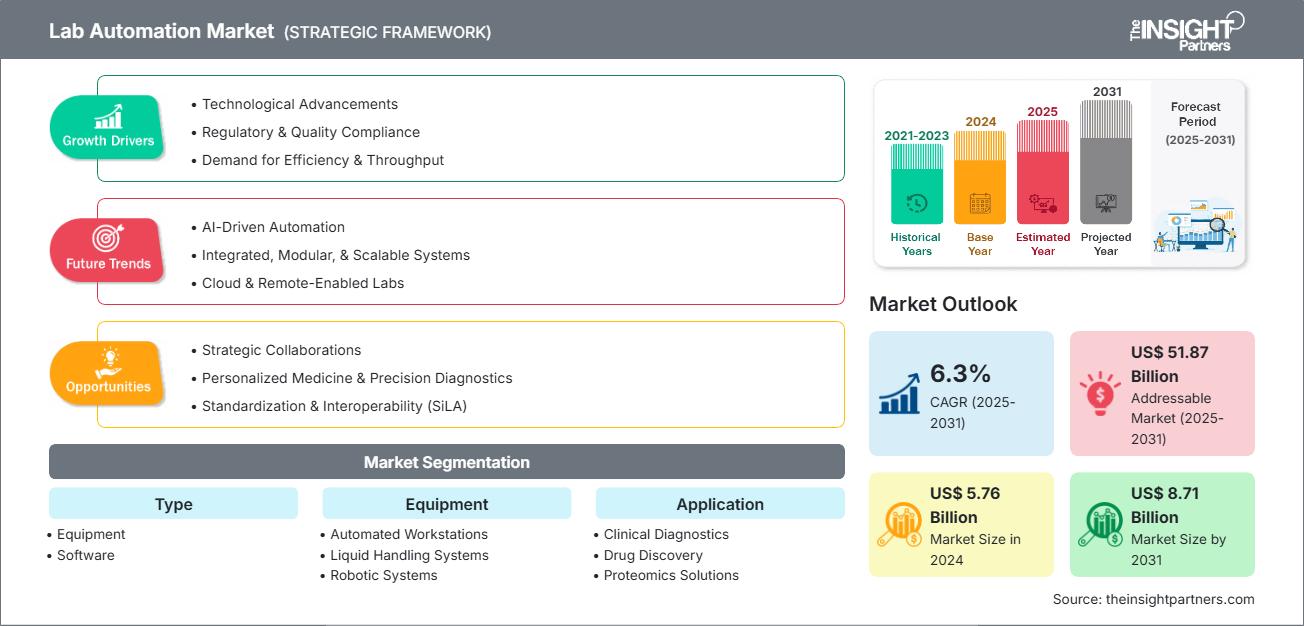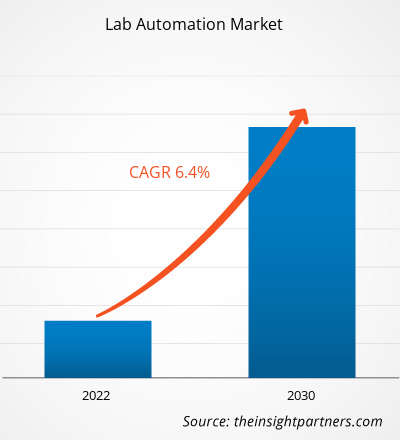[研究报告] 实验室自动化市场规模预计将从 2022 年的 51.6631 亿美元增长到 2030 年的 84.8327 亿美元;预计 2022 年至 2030 年的复合年增长率为 6.4%。
实验室自动化市场洞察和分析师观点:
将自动化集成到实验室中以实现新的和增强的实验室流程被称为实验室自动化。实验室机器人技术是实验室自动化技术最著名的应用。此外,实验室自动化涵盖各种自动化实验室仪器、设备、软件算法和方法,用于实现、加速和提高实验室研究的效率。根据实验室自动化市场分析,推动实验室自动化市场发展的关键因素是实验室自动化和不断发展的制药行业提供的不断增长的应用和优势。然而,由于高昂的资本投入,实验室自动化的采用有限,阻碍了实验室自动化市场的增长。
增长动力与制约因素:
生物技术、制药、临床诊断、学术研究和环境检测是实验室自动化应用增长的主要行业。对实验室流程效率、精度和吞吐量的要求推动了对实验室自动化的需求。自动化技术的使用带来了诸多益处,可以对科研开发的生产力和质量产生重大影响。其主要优势和应用包括高通量筛选、样品制备和处理、数据管理和集成、工作流程优化、灵活性和定制化、质量控制和保证、资源优化、长期成本节约、减少危险化学品或生物材料的人工处理,以及扩大实验室的容量和能力。因此,实验室自动化的优势越来越明显,这凸显了它如何能够改变各个行业的科研开发。随着技术的发展,预计实验室自动化程度将不断提高,从而推动科研项目的效率和创新。然而,许多公司,尤其是生物技术和制药行业的公司,由于高昂的资本支出,在采用实验室自动化方面遇到了重大问题。虽然实验室自动化提供了诸多优势,例如更高的效率、准确性和吞吐量,但部署自动化系统的初始成本对于某些企业来说可能难以承受。各种因素导致实验室自动化所需的高额资本投入,例如设备成本、基础设施要求、集成和定制、维护和支持、高专业知识要求以及技术过时的风险。例如,根据 Retisoft Inc. 的数据,小型自动化机器人系统的价格在 10 万至 30 万美元之间。然而,更复杂、更大型的实验室自动化系统通常成本超过 100 万美元。因此,实验室自动化所需的高额资本投入可能会阻碍许多生物技术和制药公司采用实验室自动化,尤其是资金有限的小型或新兴组织。因此,上述因素可能会阻碍全球实验室自动化市场的增长。
自定义此报告以满足您的要求
您将免费获得任何报告的定制,包括本报告的部分内容,或国家级分析、Excel 数据包,以及为初创企业和大学提供超值优惠和折扣
实验室自动化市场: 战略洞察

-
获取本报告的主要市场趋势。这个免费样本将包括数据分析,从市场趋势到估计和预测。
报告细分和范围:
全球实验室自动化市场报告根据产品、应用和最终用户进行细分。根据产品,实验室自动化市场分为设备和软件。根据设备,市场细分为自动化工作站、微孔板读数仪、机器人系统、现成的自动化工作单元、自动化存储和检索系统 (ASRS) 等。根据软件,市场细分为实验室执行系统 (LES)、实验室信息管理系统 (LIMS)、电子实验室笔记本 (ELN) 和科学数据管理系统 (SDMS)。根据应用,实验室自动化市场分为临床诊断、药物发现、蛋白质组学解决方案、基因组学解决方案等。根据最终用户,实验室自动化市场分为制药公司、医院和诊断中心、教育和研究机构以及合同研究组织。根据地域划分,实验室自动化市场报告分为北美(美国、加拿大和墨西哥)、欧洲(德国、法国、意大利、英国、俄罗斯和欧洲其他地区)、亚太地区(澳大利亚、中国、日本、印度、韩国和亚太其他地区)、中东和非洲(南非、沙特阿拉伯、阿联酋和中东和非洲其他地区)以及南美洲和中美洲(巴西、阿根廷和南美洲和中美洲其他地区)。
分段分析:
根据产品,实验室自动化市场分为设备和软件。2022 年,设备部门在实验室自动化市场中占有较大份额。但是,根据实验室自动化市场预测,预计软件部门在 2022 年至 2030 年期间的复合年增长率将更高。
根据设备,实验室自动化市场细分为自动化工作站、液体处理系统、机器人系统、微孔板读数仪、自动存储和检索系统 (ASRS) 等
根据应用,实验室自动化市场分为临床诊断、药物发现、蛋白质组学解决方案、基因组学解决方案等。2022 年,药物发现领域在实验室自动化市场规模中占有最大份额。然而,根据实验室自动化市场预测,临床诊断领域预计在 2022 年至 2030 年期间实现最高复合年增长率。
根据最终用户,实验室自动化市场细分为制药公司、医院和诊断中心、教育和研究机构以及合同研究组织。2022 年,制药公司领域在实验室自动化市场规模中占有最大份额。然而,根据实验室自动化市场预测,医院和诊断中心部门预计在 2022 年至 2030 年期间的复合年增长率最高。
区域分析:
根据地域划分,全球实验室自动化市场分为五个主要区域:北美、欧洲、亚太地区、南美和中美以及中东和非洲。
2022 年,北美在全球实验室自动化市场中占有最大份额。美国医疗基础设施的发展和医疗服务支出的增加正在推动该国实验室自动化市场的发展。实验室自动化在临床试验、药物开发和生物医学研究中的应用对实验室自动化市场的增长产生了重大影响。这些系统还可以在很少的监督和指导下长时间运行,使研究人员能够专注于他们的主要工作,而减少在重复性活动上的时间。此外,医疗保险和医疗补助服务中心美国医疗补助服务中心 (CMS) 已根据《临床实验室改进修正案》(CLIA) 采用了与人体实验室研究相关的标准,这促进了实验室自动化市场的增长。
实验室自动化
实验室自动化市场区域洞察The Insight Partners 的分析师已详尽阐述了预测期内影响实验室自动化市场的区域趋势和因素。本节还讨论了北美、欧洲、亚太地区、中东和非洲以及南美和中美洲的实验室自动化市场细分和地域分布。
实验室自动化市场报告范围
| 报告属性 | 细节 |
|---|---|
| 市场规模 2024 | US$ 5.76 Billion |
| 市场规模 2031 | US$ 8.71 Billion |
| 全球复合年增长率 (2025 - 2031) | 6.3% |
| 历史数据 | 2021-2023 |
| 预测期 | 2025-2031 |
| 涵盖的领域 |
By 类型
|
| 覆盖地区和国家 |
北美
|
| 市场领导者和主要公司简介 |
|
实验室自动化市场参与者密度:了解其对业务动态的影响
实验室自动化市场正在快速增长,这得益于终端用户需求的不断增长,而这些需求的驱动因素包括消费者偏好的不断变化、技术进步以及对产品优势的认知度不断提高。随着需求的增长,企业正在扩展其产品线,不断创新以满足消费者需求,并抓住新兴趋势,从而进一步推动市场增长。

- 获取 实验室自动化市场 主要参与者概述
全球实验室自动化市场主要参与者采取的各种举措如下:
- 2023年5月,Opentrons宣布推出Opentrons Flex机器人,这是一款价格合理、易于编程的创新型液体处理实验室机器人,它将为各种规模的实验室创造公平的竞争环境,并使更多研究人员能够比以往更轻松地使用先进的实验室自动化技术。Flex机器人将尖端机器人技术与庞大的开源软件生态系统相结合。它可以与AI工具配合使用,并拥有几乎无限的新协议选择能力。
- 2023年3月,Brooks Automation US, LLC宣布收购Aim Lab Automation Technologies Pty Ltd.。Brooks收购Aim Lab符合其在实验室自动化市场提供更多解决方案的扩张计划。凭借其PreciseFlex产品解决方案,Brooks引领生命科学协作自动化市场。此次收购提升了 Brooks 在临床诊断领域的地位,使其超越了药物研发领域。凭借 PreciseFlex,Aim Lab 将为客户提供更强大的功能、更广阔的全球布局以及更紧密合作的机会。
- 2023 年 2 月,Automata 推出了 LINQ,这是一个全新的开放式集成实验室自动化平台。LINQ 平台包含一个内置自动化工具的专用实验台和强大的内部实验室编排软件。因此,实验室可以提高效率和准确性,同时减少人工操作,而无需为大型复杂设备增加更多空间。
- 2023 年 1 月,BD(碧迪公司)推出了一款用于 BD Kiestra 微生物实验室解决方案的机器人追踪系统。该系统可实现实验室样本处理的自动化,从而最大程度地减少人工操作并缩短等待时间。借助全新的 BD Kiestra 第三代全实验室自动化系统,实验室可以连接各种 BD Kiestra 模块,构建独特且适应性强的全实验室自动化配置。它还具有可扩展性,以适应实验室不断变化的需求。通过选择各种轨道配置和机器,实验室可以定制自动化系统,以匹配其独特的工作流程和物理实验室空间。
- 2022年6月,Insilico Medicine推出了一个由AI运行的机器人实验室。它是Insilico端到端AI驱动药物发现平台在现实世界中的互联扩展。它将由其AI系统远程控制,由自动导引车代替人类科学家进行实验。这些机器人将进行细胞培养、高通量筛选、下一代测序、细胞成像以及基因组学分析和预测。
- 2021年5月,贝克曼库尔特宣布全球推出DxA 5000 Fit。 DxA 5000 Fit 是一款工作流程自动化系统,适用于每日检测次数少于 5,000 次的中型实验室。
竞争格局和主要公司:
西门子医疗、赛默飞世尔科技、耶拿分析仪器有限公司、Labman Automation Ltd、BD、Brooks Automation Inc、bioMerieux SA、CrelioHealth Inc.、丹纳赫集团和罗氏公司是实验室自动化市场的领军企业。这些公司专注于新技术、现有产品的改进和地域扩张,以满足全球日益增长的消费者需求,并丰富其专业产品组合。
- 历史分析(2 年)、基准年、预测(7 年)及复合年增长率
- PEST和SWOT分析
- 市场规模、价值/数量 - 全球、区域、国家
- 行业和竞争格局
- Excel 数据集
近期报告
客户评价
购买理由
- 明智的决策
- 了解市场动态
- 竞争分析
- 客户洞察
- 市场预测
- 风险规避
- 战略规划
- 投资论证
- 识别新兴市场
- 优化营销策略
- 提升运营效率
- 顺应监管趋势






















 获取免费样品 - 实验室自动化市场
获取免费样品 - 实验室自动化市场